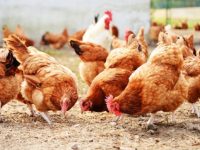 LONDON (Reuters) – A wave of H7N9 bird flu in China that has spread into people may have the potential to emerge as a pandemic strain in humans, scientists said on Wednesday.
LONDON (Reuters) – A wave of H7N9 bird flu in China that has spread into people may have the potential to emerge as a pandemic strain in humans, scientists said on Wednesday.
The H7N9 virus, one of several strains of bird flu known to be able to infect humans, has persisted, diversified and spread in chickens across China, the researchers said, fuelling a resurgence of infections in people and posing a wider threat.
“The expansion of genetic diversity and geographical spread indicates that, unless effective control measures are in place, H7N9 could be expected to persist and spread beyond the region,” they said in a study published in the journal Nature.
The H7N9 bird flu virus emerged in humans in March 2013 and has since then infected at least 571 people in China, Taipei, Hong Kong, Malaysia and Canada, killing 212 of them, according to February data from the World Health Organization (WHO).
After an initial flare up of human cases at the start of 2013, the H7N9 appeared to die down — aided in large part by Chinese authorities deciding to close live poultry markets and issue health warnings about direct contact with chickens.
But infections in people increased again last year and in early 2015, prompting researchers to try to understand more about how the virus re-emerged, how it might develop, and how it might threaten public health.
In this study, an international team of scientists led by Yi Guan of Hong Kong university monitored the evolution and spread of H7N9 over 15 cities across five provinces in China.
By collecting and sequencing a large number of samples, they found that the H7N9 virus is mutating frequently, acquiring genetic changes that might increase its pandemic potential.
A large number of new genetic variants of the virus have become established in chickens and have spread across the country, probably because of poultry trade movement, they said.
Flu experts not directly involved in the research said its findings were interesting but did not necessarily show the H7N9 was changing in ways that made it more likely to develop into a pandemic flu strain.
“What we don’t know from this paper is the significance of all these mutations that are accumulating as the virus persists and spreads,” said Wendy Barclay, an expert in flu virology at Britain’s Imperial College London. “This is especially relevant for human health — does any of this change the pandemic potential of the virus?”
In its latest update on the flu strain, the Geneva-based WHO said it “continues to closely monitor the H7N9 situation” and conduct risk assessments.
“So far, the overall risk associated with the H7N9 virus has not changed,” it said.
Yi Guan’s team, however, said their analysis pointed to a need for heightened vigilance of H7N9 and for curbing direct human contact with live poultry at markets.
“Permanent closure of live poultry markets, central slaughtering and preventing inter-regional poultry transportation during disease outbreaks are needed to reduce the threat of H7N9 to public health,” they wrote.
(Reporting by Kate Kelland; Editing by Ruth Pitchford)



